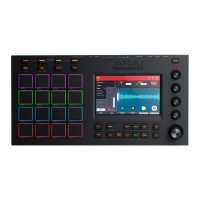
Do you have a question about the Akai MPC Touch and is the answer not in the manual?
| Display type | LED |
|---|---|
| Built-in display | Yes |
| Product color | Black |
| USB direct playback | - |
| Built-in optical drive | No |
| Audio (L/R) in | 2 |
| Minimum RAM | 4 GB |
| Minimum processor | Dual Core |
| Minimum processor speed | 2.5 GHz |
| Minimum storage drive space | 2048 MB |
| Mac operating systems supported | Mac OS X 10.10 Yosemite, Mac OS X 10.11 El Capitan, Mac OS X 10.9 Mavericks |
| Windows operating systems supported | Windows 10 Education, Windows 10 Education x64, Windows 10 Enterprise, Windows 10 Enterprise x64, Windows 10 Home, Windows 10 Home x64, Windows 10 Pro, Windows 10 Pro x64, Windows 8 |
Find information on product requirements, compatibility, and registration.
Explains the manual's structure, terminology, and formatting conventions.
Steps to download and install MPC software and drivers.
Example diagram showing MPC Touch hardware connections.
Initial steps for powering on, opening software, and authorization.
Detailed instructions for unlocking and registering the MPC software.
Explains the functions of physical controls on the MPC Touch.
Information on using the MPC Touch display interface and navigation.
Details on the various ports and connections on the rear panel.
Ensure drivers, software, and hardware are connected and ready.
Guide to loading samples and creating a drum kit.
Instructions for recording drum patterns using pads and sequence.
Guidance on renaming programs and samples for better organization.
How to view and edit recorded MIDI note data in Grid View.
Adjusting volume, panning, and tuning of samples in Program Edit Mode.
Steps to create a new track and record a bass line.
How to arrange sequences into songs using Song Mode.
Process for exporting the final song as an audio mixdown.
Using pads as step buttons to create sequences.
How to slice drum loops into individual samples.
Silencing pads or tracks to isolate sounds.
Guide to recording new audio samples using the Sampler.
Using Sample Edit Mode for trimming and adjusting samples.
Automating parameters using the XY pad for dynamic effects.
How to use MPC software within a DAW.
Covers fundamental MPC Touch and software features.
Explains different UI elements like knobs, sliders, and menus.
Describes how envelopes shape sound over time.
Icons for editing note events in Grid View.
Details the various operational modes of the MPC Touch.
Overview of the most-used functions and navigation.
Viewing and editing note events and velocities in a grid.
Overview of tracks in a sequence for simultaneous editing.
Creating/editing sequences using pads as step buttons.
Using the touchscreen as an XY pad for effect automation.
Editing samples using functions like trimming and slicing.
Editing samples within the context of a program.
Recording audio samples using the MPC Touch.
Muting individual pads or setting mute groups.
Adjusting levels, panning, routing, and effects for pads.
Triggering sequences via pads for live performance.
Editing parameters for each pad within a program.
Recording and overdubbing audio in real-time.
Muting tracks or setting mute groups for tracks.
Setting levels, panning, and effects for tracks, programs, etc.
Lists available effects and their parameters.
Parameters and settings for various reverb effects.
Parameters and settings for various delay effects.
Parameters and settings for flanger effects.
Parameters and settings for chorus effects.
Parameters and settings for autopan effects.
Parameters and settings for tremolo effects.
Parameters and settings for phaser effects.
Parameters and settings for high-pass filter effects.
Parameters and settings for low-pass filter effects.
Parameters and settings for parametric equalizer effects.
Parameters and settings for distortion effects.
Parameters and settings for compressor effects.
Parameters and settings for bit reduction effects.
Parameters and settings for other effects like Auto Wah.